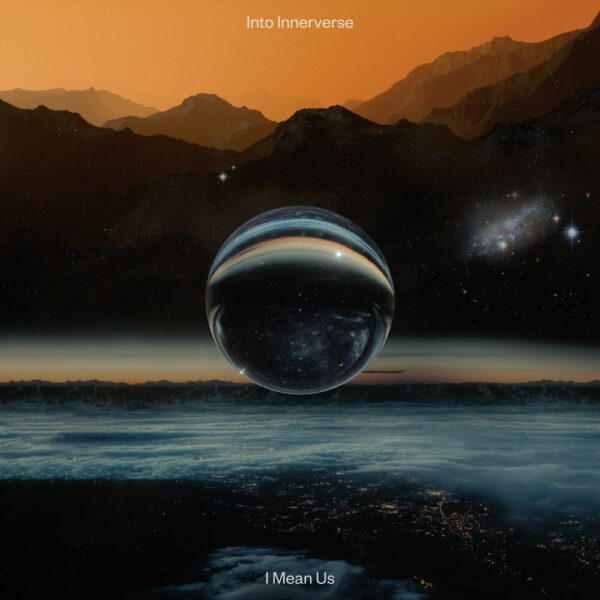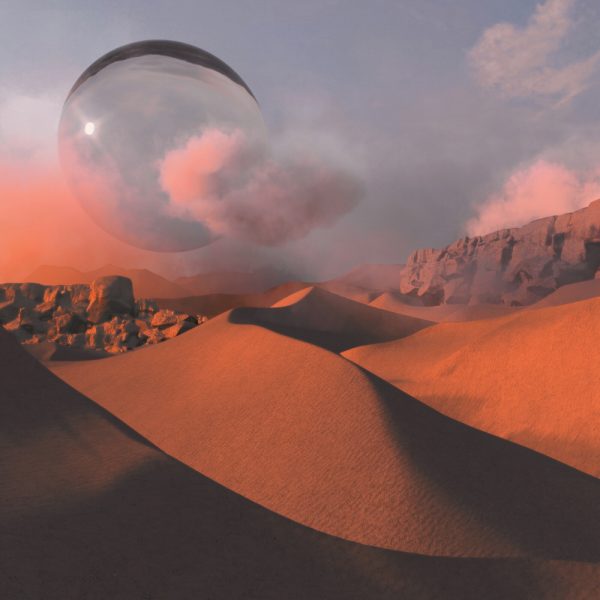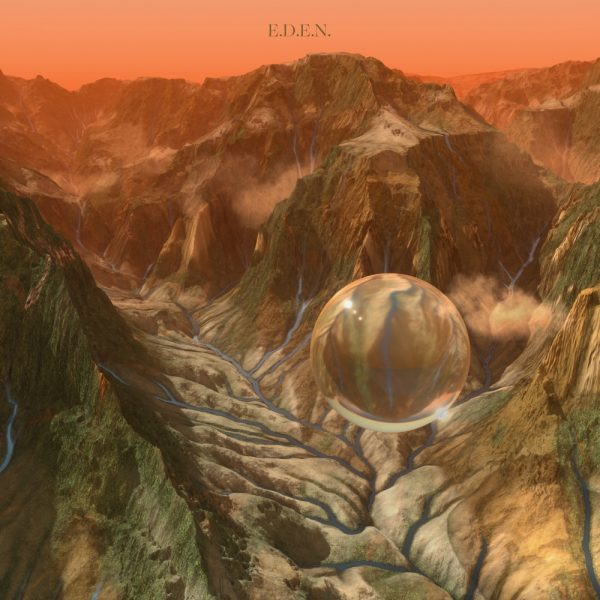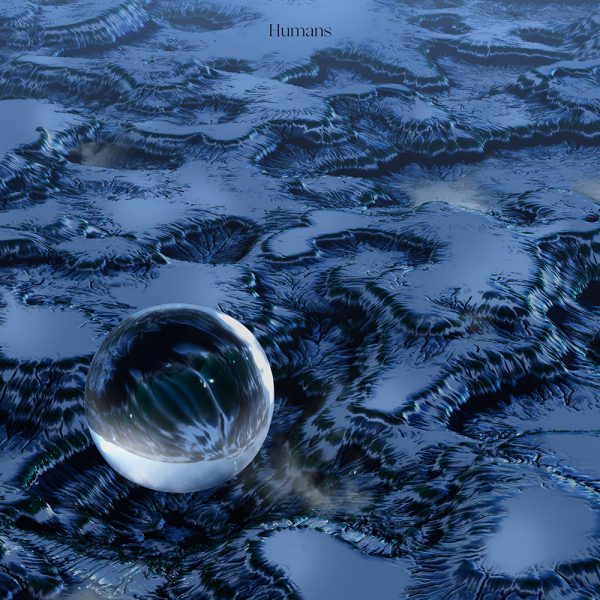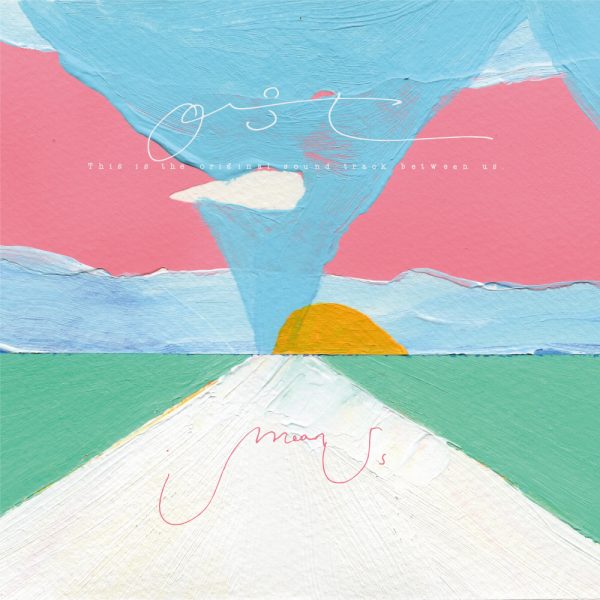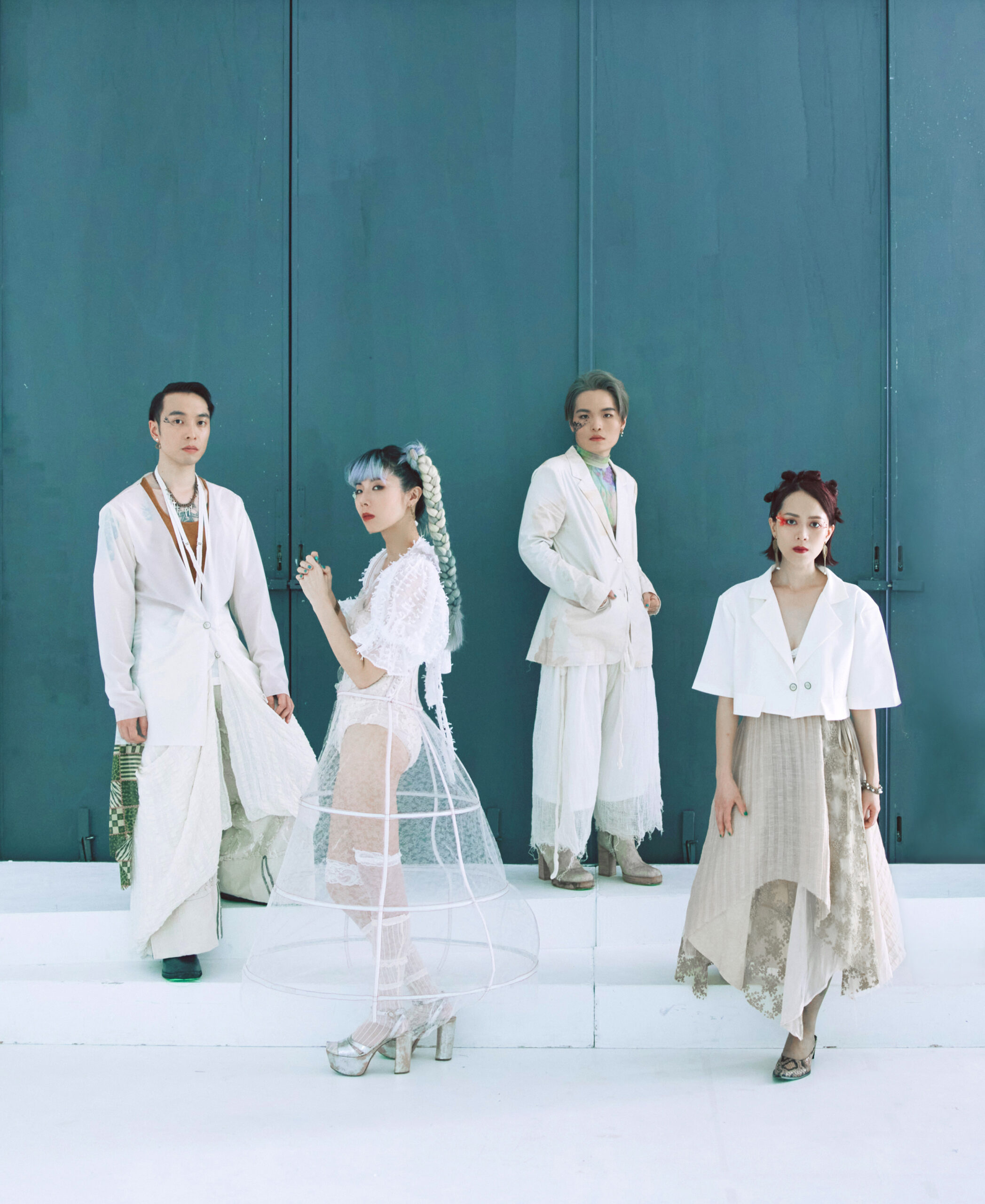
그러니까, I Mean Us는 우리들입니다.
I mean, I Mean Us is us.
안타깝게도, ‘나’가 정말로 ‘우리’를 뜻하지는 않는다. 그럼에도, “I Mean Us”, ‘나’가 ‘우리’를 의미한다고, 혹은 “I’M U”, ‘나’는 ‘너’라고 발화하면, 분명하게 나뉜 줄 알았던 의미 값들이 서로에게 충돌하고 각자와 겹쳐지며 인상적인 장면들이 나타날 수 있다. 대만의 인디 팝 밴드 I Mean Us의 음악에서도 마찬가지의 현장이 만들어진다. 록 밴드로서 주로 사용하는 악기들부터 온갖 전자음을 만들어내는 신스와 가상악기들, 오랜 역사의 관현악기와 전통 악기 등에 얽힌 장르적 특징을 결합하며, I Mean Us는 웅장하고 극적이게 펼쳐지는 사운드스케이프로 꿈과 상상, 혹은 기억과 같은 신비한 세계를 만들어보고자 한다.
두 번째 정규 음반인 [Into Innerverse]에서 밴드는 감정이 흔치 않아진 미래를 배경으로, 폭넓고 다채로운 내면세계로 들어가는 탐험자가 되었다. 멤버들부터 악기 소리와 구간들의 전개, 장르 문법까지 제각기 다른 요소들이 한데 모여 ‘우리’이면서도 ‘너와 나’로 풍부히 나타날 때, 몽환적인 동시에 직설적이고자 하는 사운드 속에서 ‘나’와 ‘너’, 그리고 ‘우리’의 뜻은 정말로 가까워질지 모른다. 한국의 청자들에게는 아직은 낯설 I Mean Us의 세계에 대해 메일과 번역을 거쳐 질문을 보내, ‘이너버스’의 여행자들을 위한 안내서를 그 답변으로 받아보았다.
Q. 안녕하세요, 반갑습니다! 이미 [OST]가 Beeline Records를 통해 한국에서도 정식 발매되기도 했지만, 이번에 [Into Innerverse]로 처음 만나는 청자들을 위해 I Mean Us를 간략하게 소개해 주실 수 있을까요?
안녕하세요 여러분. 우리는 대만의 인디팝 밴드 I Mean Us입니다. Sigur Rós, M83 그리고 Agnes Obel에게 큰 영향을 받았고, 드림팝을 기반으로 포스트록, 사이키델릭, 슈게이징과 클래식 음악의 요소들을 결합한 음악을 만들고 있습니다.
I Mean Us의 음악에서는 현대의 악기들과 관현악기와 전자음, 신비로운 사운드들이 조화를 이룹니다. 이러한 풍부한 요소들로, 우리의 음악은 사람들의 사고를 제한하지 않고, 청자들을 가능성으로 가득 찬 차원으로 인도합니다. Into Innerverse는 모든 종류의 상상, 감정, 기억들을 들여다볼 수 있는 프리즘이 될 것입니다.
Q. I Mean Us, 가끔씩 줄여서 ‘I’m U’이나 IMU로도 표현되는 팀명이 참 흥미롭다고 생각했습니다. 한 이름 속에 ‘나’와 ‘우리’와 ‘너’가 다 함께 있다는 게 마음에 들더라고요. 혹시 팀명에 의미가 있다면 무엇인지, 어떻게 아이디어를 떠올렸는지 알려주실 수 있나요?
밴드의 이름은 우리가 밴드를 시작하기 전에 이미 일상의 대화 속에서 나왔던 말이에요. 누군가가 “I mean us”라고 말했고 그 이름이 우리를 바로 뭉치게 했습니다. 음악도 우리에게 비슷한 의미를 지니는 것 같아요. 공연이나 파티 장면들을 보면, 사람들은 음악 속에서 하나가 되어 기쁨과 슬픔을 나누잖아요.
Q. 이러한 팀명에서는 바이오그래피에서 “각기 다른 모든 악기, 아이디어와 생각을 하나로 통합하는 것(uniting every single piece of different instruments, ideas and thoughts as one)”이라고 하신 것도 생각났는데, 이 문장이 마치 밴드의 형태로 음악을 하는 이야기처럼 느껴지더라고요. 하나의 ‘밴드’로서 I Mean Us가 지향하는 음악이나 그 이미지가 있다면 무엇인가요?
우리가 특별히 집중하고 있는 장르는 없어요. 모든 멤버들은 각각 다른 음악적인 배경과 취향을 가지고 있습니다. 클래식부터 포스트록, 전자음악, 한국 힙합까지 모든 장르를 포함해요.
우리는 모든 악기, 아이디어 그리고 생각들이 각 멤버들의 강점과 취향이 드러나는 응축된 문장으로 결합되는 걸 목표로 합니다. 밴드로서 우리가 함께일 때 우리만이 할 수 있는 음악을 만들고 싶어요.
Q. I Mean Us의 음악에서 또한 ‘각기 다른 부분이 통합된 전체’와 비슷한 인상이 들었어요. 신시사이저와 전기기타 모두가 다른 소리를 내지만 균형을 잡으면서, 선잠을 잘 때 꾸는 꿈같은 분위기의 사운드를 만드는 인상이 느껴졌습니다. 작업을 하실 때에 이렇게 ‘분위기’를 만드는 것에 있어 가장 집중하는 점이 있다면 무엇인가요?
기본적으로 처음에는 보컬라인에 집중해요. 그리고 나서 다른 악기들이나 이펙트를 매치해요. 각 악기가 가지고 있는 음색 외에도, 소리의 잔향이나 울림에 집중해서 더 몽환적인 사운드를 만들고자 합니다.
Q. [Into Innerverse]에서는 그러한 ‘균형’이 느슨하게 머물고 있던 드림 팝의 기반을 아예 떠나서, 악기들을 더 폭넓게 사용하며 가볼 수 있는 많은 영역들을 탐색하는 느낌입니다. 이번 음반을 “전적으로 새로운 여정(whole new journey)”이라 부르셨던 것이 함께 생각났는데요, 특히나 이번 음반에서는 어떤 측면이 ‘전적으로 새롭게’ 될 수 있도록 하셨나요?
“여정”이라는 단어는 앨범의 제목과 연관이 되어 있습니다. 우리는 청자들이 앨범을 듣는 동안 각자의 내면의 세계를 탐험하는 마음의 여정을 떠나길 바라요. 물론 더 로맨틱하고 젊음을 담고 있는 첫 번째 앨범 OST와 비교했을 때 Into Innerverse는 더 성숙하고, 어둡고, 공격적으로 느껴질지도 모릅니다. 음악적인 스타일과 주제적인 측면 모두에 있어서요. 지난 3년 동안 너무나 많은 쓰라리고 달콤한 변화들이 있었어요.
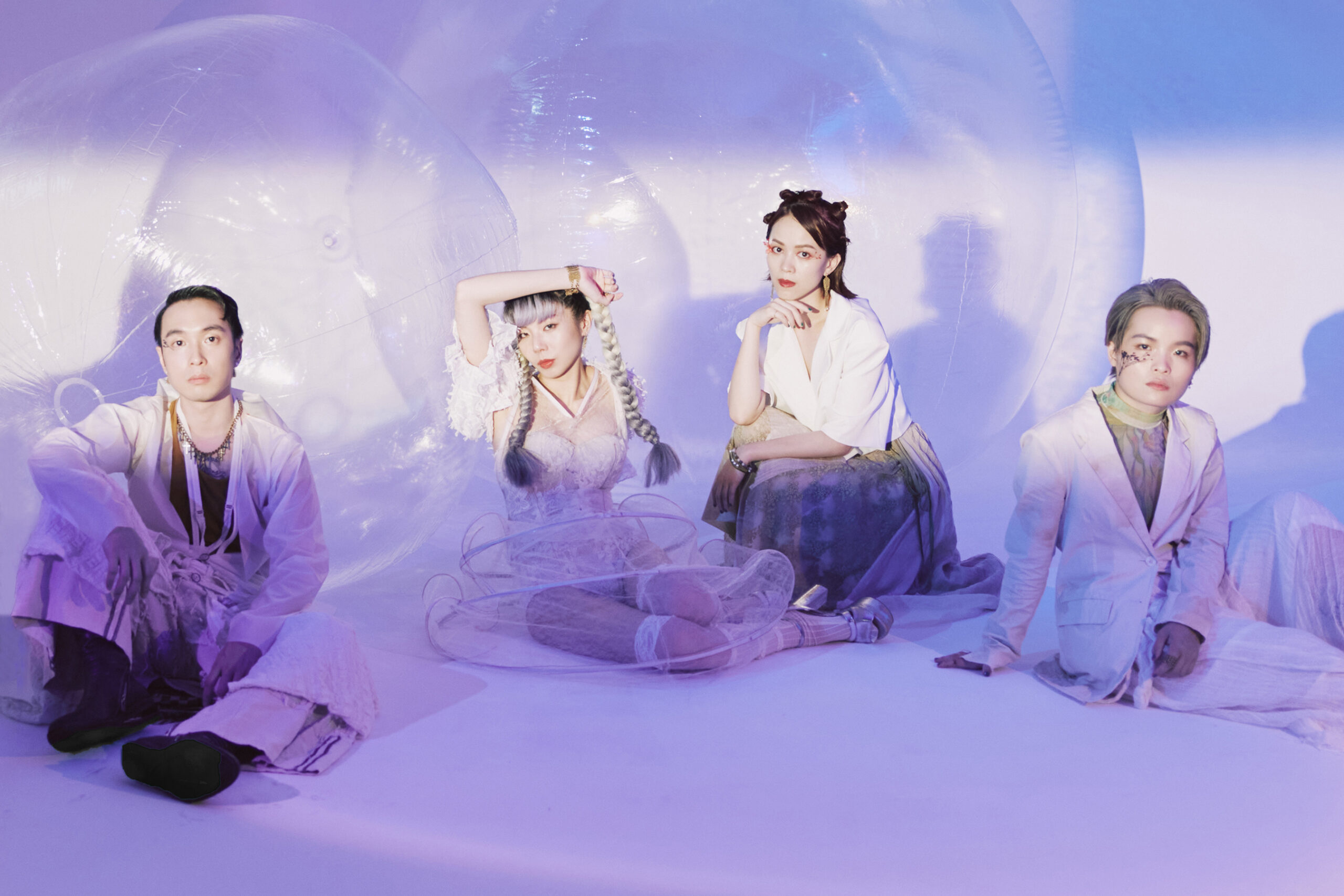
Q. 이 ‘전적으로 새롭다’는 느낌은 이번에 새로 찍으신 프로필 사진에서도 좀 느껴졌습니다. 저마다의 색깔이 담긴 흰옷을 입고 눈가에 페이스 페인팅을 한 것이 묘하게 데이비드 보위(David Bowie)의 [Aladdin Sane] 속 글램한 이미지들이 떠올랐거든요. 어쩌다가 이런 프로필 사진을 찍게 되셨는지, 그것이 [Into Innerverse]와 관련이 있는지 궁금합니다.
앨범의 비주얼 아트의 배경과 주제는 감정들이 드물고 귀중해진 초현실적인 미래를 배경으로 합니다. 수정 구슬은 감정을 전달하는 수단이고 각각의 목적지가 다른 정서적인 감각을 나타내죠.
콘셉트 회의를 기반으로, 우리의 스타일리스트 Dorene은 각 멤버들의 착장에서 먼 곳으로부터 방랑하고 있는 “수정 구슬 요정”의 이미지를 구축하려고 했습니다. 흰색이 다른 색들을 중화시켜주고, 무(無)의 개념을 상징하기 때문에 그녀는 흰색을 착장의 시각적 포인트로 사용했어요. 또 보존 처리된 꽃잎으로 만든 얼굴 장식은 사랑과 애정의 지속을 나타내고, 소중한 감정들을 지난한 시간의 흐름으로부터 지키고 영원한 기억으로 우리의 마음속에 기억으로 간직합니다.
Q. 음반 제목에 ‘Innerverse’라는 단어를 사용하셨는데, 이 ‘이너버스(Innerverse)’가 정확히 어떤 “세계”인지가 궁금해지더라고요. 밴드 자체가 탐험해 보고 싶은 어떠한 공간인지, 정말 단어 뜻 그대로 누군가의 “내적 우주” 같은 곳인지, 아니면 다른 뜻이 있는지 알려주세요.
우연히 앨범의 메인 아이디어를 지난 질문에서 이야기했네요. 우리는 사람들의 마음속에 있는 소중한 감정들을 살펴보고 지켜내길 바랍니다. 각 노래들에 특정 감정을 부과하지는 않았어요. 그저 사람들이 음악을 들으며 느꼈던 감정들을 간직하길 바라요.
Q. 이제 본격적으로 [Into Innerverse] 속 음악 얘기를 해보겠습니다. 우선 트랙들에 새로 들어온 소리가 두드러지는 편이었어요. 대표적으로는 “E.D.E.N”에서의 색소폰과 함께 몽골 지역의 전통 창법인 흐미(khoomei)의 소리가 있을 거 같네요. 어쩌다가 대중음악 트랙에서 흔히 사용하지 않는 이런 창법의 목소리를 넣었는지 알려주실 수 있으신가요?
‘E.D.E.N’의 작곡가 Chun은 트라이벌한 사운드에 주목하고 있어요. 그는 전세계 곳곳에 있는 오래된 노래들이 어머니 지구에 대한 사랑으로 깊이 연결되어 있다고 생각해요. ‘E.D.E.N’의 데모를 만들고 있는 중에 마침 그의 친구가 내몽골에서 흐미와 마두금을 배우고 귀국했고 친구를 초대해 콜라보레이션을 진행했습니다. Chun이 전통음악에 대해 전문가는 아니지만, 이 트랙의 작곡가로서 곡의 사이키델릭한 분위기와 흐미가 완벽하게 호응할 것이라는 걸 알았죠. 흐미 파트의 가사는 “욕정을 삼가라”라는 의미로, 문수보살(Manjushri)의 진언에서 유래되었습니다.
Q. “E.D.E.N” 얘기를 좀 더 하자면 ‘네오 사이키델리아’나 ‘드림 팝’의 분위기를 강조하던 전작과는 거리가 꽤 먼 것에도 불구하고, 굉장히 댄서블해서 무척 즐거웠습니다. 신스음을 중심으로 반복적인 그루브를 강조한 건 “E.D.E.N”의 앞뒤에 놓인 “普通人類”이나 “I Dot Car”에서도 그랬고요. 어떻게 해서 이런 트랙들에서 그루브나 리듬감을 특히 강조하게 되었는지 궁금합니다. 조금 더해서, 춤추게 하는 음악들을 꿈꾸게 하는 음악들보다 좋아하시는지요?
둘 다 좋습니다! 공중에서 부유하는 것과 땅 위에서 춤추는 것 둘 다요.
‘I Dot Car’는 우리가 함부로 보냈던 어느 멋진 밤을 위한 노래에요. 이 곡의 믹싱 엔지니어인 Caesar Edmunds는 이 노래가 고등학교 무도회를 떠올리게 한다고 했어요, 하하.
‘普通人類 Humans’를 만들 때 우리가 집중했던 단 한 가지는 “더 스타일리시하면서도 거침없는 사운드를 만들자”였습니다. 절대 “댄서블”하게 만들려고 하지는 않았어요.
Q. 한편, 한 트랙 안에서도 분위기나 박자, 장르적인 특징이 지속적으로 뒤바뀔 때가 많다고 느껴졌습니다. 마지막으로 “E.D.E.N” 얘기를 하자면 곡 내의 강약의 조절이 굉장히 극적인 것도 있었고요, 그러다 보니 무언가 지난 음반의 제목이 ‘OST’였던 것도 떠올랐습니다. 이를테면 “Run Ran Run”의 도입부나 브릿지 구간들이 트랙에 ‘삽입’된 듯 들어간 것이 은근히 블록버스터 영화의 시퀀스처럼 느껴지기도 했거든요. 이외에도 “普通人類”의 도입부나 장엄한 “Muséum”의 시계 소리 효과음이 비슷한 감상을 줬는데, 곡 작업을 할 때 어떤 극적인 이미지나 진행을 염두에 두셨는지 궁금합니다.
‘Muséum’은 평화와 슬픔으로 가득 찬 혼란 속의 꿈과 같습니다. 도입부의 퍼커션은 시간에 대한 감각을 의미하고 반복되고 패닝하는 리버스 기타 사운드와 함께 우리 머릿속의 작은 카오스를 포착합니다.
‘普通人類 Humans’에서는 무감각의 차원에서 비생물적인 존재가 된 당신을 떠올리게 됩니다. 이 곡에는 이교도적이고 종교적인 의식을 떠올리게 하는 사운드를 넣었어요.
‘Run Ran Run’의 이미지는 바쁜 날을 보내고 한 후 침대에 누워 자신만의 시간을 보내고 있는 당신과 닮아 있습니다.
Q. [Into Innerverse]에는 현악기를 사용하는 트랙들도 있었습니다. “Run Ran Run”에서는 컨트리나 웨스턴 음악과 같은 스트링 솔로가 들어오고, “9”에서는 왈츠가 울려 퍼지는 무도회장처럼 나타난 현악 연주가 자연스럽게 분위기를 전환시키네요. 이런 식의 사운드가 록에 현악기를 접목시키는 일반적인 방법들과 조금 다르다는 느낌도 들었는데, 스트링 세션을 어떤 방식으로 활용하려 하셨나요?
두 노래에서는 실제 브라스, 스트링 세션과 녹음했어요. ‘9’는 감정들을 차곡차곡 쌓아 올리는 곡이고, 첫 번째 파트와 두 번째 파트의 갭이 상당히 큰 곡이에요. 프로듀서는 브라스의 톤과 텐션이 곡을 하나로 만들어주는 연결 고리의 역할을 할 것이라 생각했습니다. 또한 두 번째 파트의 (왈츠풍의) 우아한 분위기는 오케스트라로 인해 두드러지죠.
‘Run Ran Run’의 작곡가의 의도대로 원 데모에서 스트링과 바이올린을 추가했습니다. 우리는 모두 넓고 광대한 느낌을 좋아하는데, 도입부가 마치 옛 중국에서 말을 타고 달리는 것과 같은 느낌을 준다고 농담처럼 이야기하기도 해요. 프로듀서는 이 노래에서 블루그래스의 정신이 느껴진다고 했는데, 와이드한 코러스와 스트링을 사용해서 클라이맥스 부분을 만들고자 했어요. 아웃트로를 들을 때 모두가 “와우!”라고 느낄만한 요소를 느꼈으면 좋겠습니다.
Q. 굉장히 인상적인 톤의 건반과 함께 현악기를 탄탄히 적용한 “24 Years Old of You”는 음반에서 특히나 돋보이는 곡입니다. 싱글로서는 이번 음반과 지난 음반 사이에 놓인 연결점 같은 위치에 있기도 하고, 변하는 것과 변하지 않는 것에 대한 가사(“Something begin to change and embrace / But you might not know that my feelings will never change”)도 있어서, [Into Innerverse]의 정수가 담겨있다는 느낌이 들기도 했습니다. 이 곡에서 가장 중점으로 두었던 요소가 있다면, 어떤 걸 담아보려 하셨는지 궁금합니다.
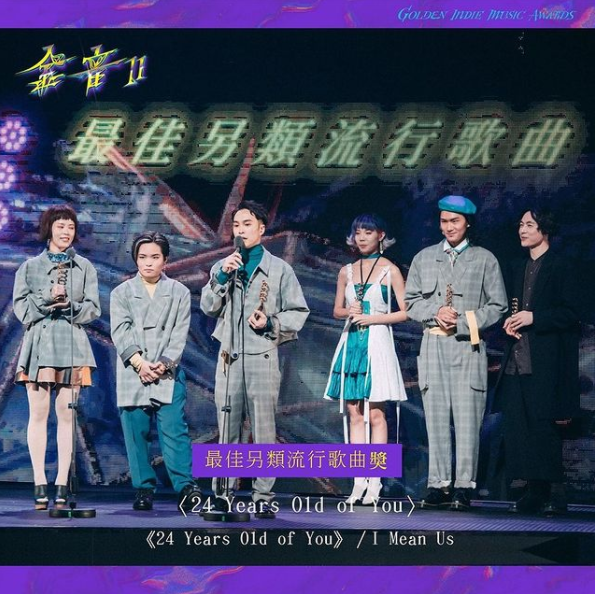
24 Years Old of You’는 I Mean Us에게 굉장히 중요한 곡이에요. 대만의 멋진 시상식에서 상을 받게 해주었고, 밴드로서 우리의 발전을 나타내기도 합니다.
작곡가인 Mandark는 이곡의 특별한 요소로, 오보에를 사용해야 한다고 주장했습니다. 그녀는 보통 머릿속에 있는 멜로디와 노래의 이상적인 사운드로부터 작업을 시작해요. 그래서 오보에와 스트링 사운드가 그 노래에 들어가야 한다고 주장한 거죠. 프로듀서인 LUB의 제안으로 오보에와 스트링 사운드를 실제 악기의 질감과 가장 비슷하게 구현했지만 더 독특한 느낌을 주는 신스와 가상악기를 사용했습니다. 우리 모두 그게 마음에 들었어요.
Q. 이번엔 노랫말에 대해서 조금 질문을 드리겠습니다. 개인적으로는 음반 내내 ‘너’와 ‘나’가 함께 혼란스러운 감정들의 공간 속에서 헤맨다는 느낌이 들었어요. 첫 곡인 “Muséum”에서 제시되는 ‘Suddenly awake from the end of the dreams’이나 ‘What if we turned around / There’s nothing there?‘에서 불안하게 요동치는 심정이 음반이 진행될수록 격해진다고 느껴졌는데요, [Into Innerverse]를 관통하는 감정이 있다면 무엇이라고 할 수 있을까요?
각각의 노래를 독립적인 개인이라고 생각했습니다. 가사와 감정의 측면에서, 듣는 사람이 자신만의 방식으로 해석할 수 있는 여지들을 남겨두고 싶었어요.
굳이 이야기하자면, 어떤 감정이든 좋고 나쁜 건 없어요. 그저 지켜보고, 느끼고, 받아들이는 거죠. 어느 날 우리가 이 세상을 떠나야 한다면, 그게 완전히 나쁜 것만은 아닐 거예요. 끝은 언제나 새로운 시작을 동반하니까요. 모든 감정을 평가하거나 정의할 필요는 없다고 생각해요. 그저 흘러가게 놔두는 거죠.
Q. 조금 뜬금없게 느껴질 수도 있긴 한데, 음반의 8번째 곡이자 마지막 곡의 제목이 하필 “9”더라고요. 이런 불일치가 일종의 농담처럼 느껴지기도 하는 한편, ‘Fear landing / Inside your heart and you break’ 같은 가사를 보면 “Muséum”에서 시작된 혼란이 제대로 해소되지 않은 채 끝난다는 인상도 있습니다. “9”의 진행 또한 에너지가 가장 높이 오른 부분이 갑작스레 뚝 끊기면서 음반을 끝내는 게 겹쳐지기도 했고요. 그런 의미에서, 어떻게 음반을 마무리하거나 “9”를 끝내보려 했는지 알 수 있을까요?
트랙의 순서에 대해서는 크게 의미를 두지 않았어요. 하지만 우리 모두 이 앨범을 감상하는 가장 좋은 방법은 마지막 트랙을 끝내고 ‘Muséum’으로 돌아와 반복해서 듣는 것이라고 생각했습니다. 몰입하고, 반복하는 거죠.

Q. 2018년에는 <Focus Asia 3>으로, 2019년에는 <잔다리 페스타>로 내한을 하셨습니다. 코로나19 대유행 이후 올여름에는 <On-Tact ‘ALIVE’ 축제>로 ‘온라인 내한’을 하시기도 했고요. 그중에서도 18/19년도의 내한 공연 때에 이러저러한 에피소드들이 있었다는데, 그게 어떤 것이었는지, 아니면 내한 공연 당시의 분위기가 어땠는지 알려주실 수 있으신가요?
한국에 머무르며 좋은 친구들을 많이 사귀었어요. 그 친구들과 우리의 음악을 사랑해 주는 팬들은 우리가 가장 아끼는 아름다운 것들이에요. 솔직히 한국의 음악 시장은 외국의 인디밴드가 진입하기 어려운 것 같아요. 하지만 한국의 팬들이 나날이 늘어간다는 사실에 굉장히 감사하고 있어요. 매번 한국에 갈 때마다 긍정적인 피드백도 많이 받았고요. 게다가 우리는 삼겹살의 노예에요. 사랑하는 친구들과 삼겹살/오겹살을 먹었던 순간들이 그리워요.
Q. 반대로 대만에서 열렸던 공연에 보수동쿨러(Bosudong Cooler)를 초청하기도 하셨죠. 종종 한국과 대만 밴드들 사이에서 이렇게 공연을 통해 오고 가며 만나는 일들이 많은데, 한국 공연에 함께 가고 싶은 다른 대만 밴드나, 아니면 대만 공연을 함께 하고 싶은 다른 한국 밴드가 있을까요?
우리의 친구인 淺堤 Shallow Levée와 함께 하고 싶네요. 예전에 한국에서 공연을 한 적도 있죠. 두 팀이 함께 한국에서 공연을 하게 된다면 엄청 재미있을 것 같네요. 倒車入庫 Reversing into Garage, 甜約翰 Sweet John, Deca Joins와 함께 하는 것도 좋겠네요. 대만에는 여러분들께 소개해드리고 싶은 좋은 음악가들이 굉장히 많아요.
한국에도 저희가 좋아하는 음악가들이 많아요. 잔나비, 카더가든, 우효, 장기하, 라드 뮤지엄, Mokyo, 나이트오프 등 셀 수 없이 많아요. 물론 우리 친구들인 보수동쿨러, 랜드 오브 피스, 플랫폼 스테레오, 사뮈도 사랑합니다. 지금, 드러머 PP L의 최애는 원슈타인이에요.
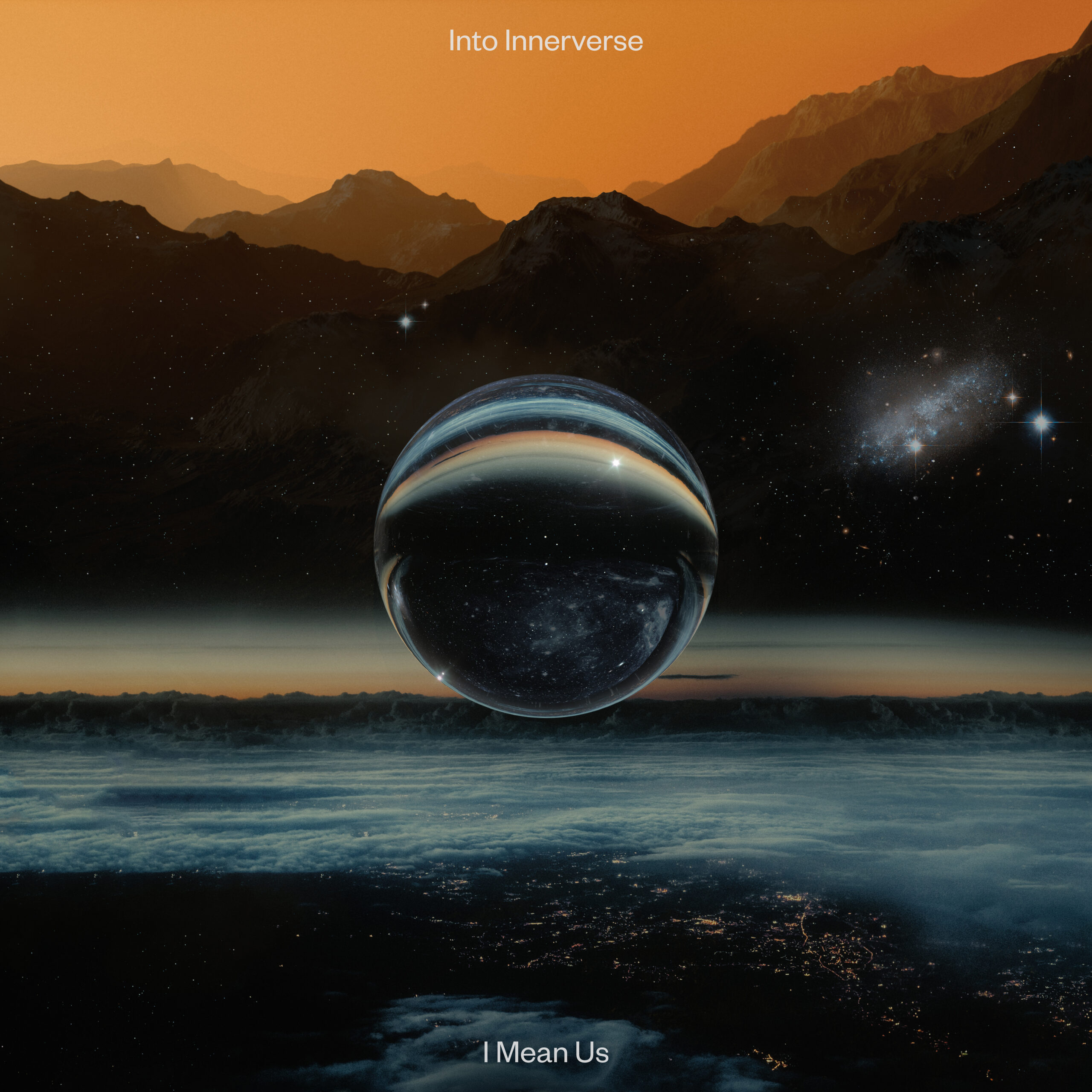
Q. 이제 마지막 질문입니다. 다시 한번 [Into Innerverse]를 되짚어보는 의미에서, 멤버분들 별로 이번 음반에서 애정이나 개인적인 의미가 많이 담겼다거나, 이것만큼은 한국의 청자들에게 추천하고 싶은 곡이 있다면 소개 부탁드리겠습니다. 감사드려요!
Vitz: ‘Muséum’과 ‘I Dot Car’ 중에 고르기가 아주 어렵네요. 둘 다 제가 처음 썼던 데모로부터 많은 변화를 겪었기 때문에 좋아해요. 두 곡 모두 소중한 밴드 멤버들과 프로듀서가 없었다면 아름답게 변하지 못했을 거예요. 우리가 함께일 때 우리가 얼마나 많은 것들을 할 수 있는지 보여주는 곡들입니다.
PP L: 사람들은 변하고 음악도 마찬가지예요. 이번 앨범은 저에게는 발전이자 성장의 증거에요. 지난 앨범인 [OST]에서 [Into Innerverse]로 오기까지 저의 연주와 편곡 실력이 더 깊이 있어졌고 풍성해졌습니다. 제 자신이 될 수 있는 공간을 마련해 준 밴드 멤버들에게 감사해요. 또 저의 개성을 지켜주면서 드럼 사운드를 더 멋지게 만들어준 프로듀서에게도 감사의 말씀을 전합니다.
Chun: ‘Run Ran Run’을 가장 추천하고 싶어요. 당신이 무엇을 얻고 무엇을 잃었는지 가만히 멈춰서 생각하게 만드는 곡입니다. 저녁노을과 잘 어울릴 거예요.
Mandark: ‘Unicode’에요. 저에게 많은 의미가 있습니다.
Hank: 우리가 만든 사운드와 음악들 이외에 앨범에서 가장 소중한 부분은 앨범의 핵심적인 아이디어라고 생각해요. 더 이상 사람들 사이에 사랑이나 로맨틱한 감정에만 집중하지 않고 죽음이나 증오, 후회와 같은 감정들도 이야기하고 있어요. 사람들이 우리의 음악을 들으며 더 많이 느끼고 상상했으면 좋겠어요.
사실 앨범의 모든 곡을 추천하고 싶지만 한 곡을 꼭 골라야 한다면 ‘I Dot Car’를 추천합니다. 젊고, 무모하고 멋진 느낌을 주는 곡입니다. 저는 그러한 정신을 소중하게 여기는데, 우리가 너무 커버린 다면 사라질 감정들이기 때문이죠.
Interview | 나원영 (대중음악비평가, 웹진 weiv 필진)
번역 및 협조 | Beeline Records
I mean, I Mean Us is us.
Hello, nice to meet you! [OST] has already been officially released in Korea through Beeline Records, but can you briefly introduce I Mean Us to the listeners who are discovering the band for the first time through “Into Innerverse”?
Hi everyone. We are I Mean Us, an indie pop band from Taiwan. Having been greatly influenced by Sigur Rós, M83 and Agnes Obel, our music is based in Dream pop, but also combines styles from genres such as Post Rock, Psychedelic Rock, Shoegaze and Classical music as well.
Modern instruments are combined delicately with orchestral and electrical/ethereal sounds in our songs. With those plentiful elements, our music won’t limit one’s thoughts. On the contrary, it can lead the audiences to a dimension full of possibilities. Into Innerverse can be that prism which reflects any kind of imaginations, emotions or memories.
I Mean Us, sometimes abbreviated as “I’m U” or IMU, thought the team name was very interesting. I liked the fact that “me,” “we” and “you” are all represented in the one name. Can you tell me what exactly the name means and how you came up with it?
Before we started the band, this name had already come up just through general conversation. Someone had said “i mean us”, and we instantly bonded over that name. We thought music meant the same thing to us. In a scene like a gig or party, it’s because of the music that people gather together to share their joy and sorrow.
In the album biography you say you are “uniting every single piece of different instruments, ideas and thoughts as one,” and this sentence felt like the story of music being told by a band. What kind of music and image is IMU aiming for as a band?
So there’s no specific genre that we try to focus on. All the members of the band have really different music backgrounds and tastes. Everything from classic music, post-rock, electronic music to Korean hip hop.
We aim to unite all the different instruments, ideas and thoughts into one cohesive sentence that shows each member’s strengths and tastes. As a band we want to make music that only we can do when we get together.
I also had a similar impression that I Mean Us’s music unites instruments, ideas and thoughts as one. Both the synthesizer and the electric guitar make different sounds, but it is balanced well and I felt the impression of a dream-like sound like I was sleeping. What do you focus on the most when making music to create this special atmosphere?
Basically we focus on the vocal lines first and then try to match them with other instruments and effects. Besides the timbre of each instrument, we focus on the reverberation and echo effects to make it sound more dreamy.
[Into Innerverse] although loosely still tied to Dream Pop feels like you’re exploring instruments more widely and searching out new musical territories to explore. I remembered that you called this album “a whole new journey,”what aspect of it did you make completely new?
The word “journey” kind of relates to the album title. We hope that the listeners can go on a journey of the mind to explore their innerverse with us while they listen to the album. Of course, compared to our first album OST which delivers a more romantic and young spirit, Into Innerverse is more mature, dark, and aggressive……? Both in terms of the music style and the topic of the songs. There have been so many bitter and sweet changes during the past three years.
This “completely new” feeling was also felt with the new profile picture you took this time. The white clothes with splashes of colour around the eyes reminded me of glam images such as David Bowie’s [Aladdin Sane]. How did this idea come about and how does it relate to the album [Into Innerverse].
The time frame/theme for the visual arts of the album is set in a surrealist future where emotions are rare and treasured. The crystal balls act as vehicles for emotional transmission, with each destination representing a different emotional sensation.
Based on the concept discussed with us, our stylist, Dorene, attempted to construct an impression of “crystal ball fairies” for the band members’ attire —vagabond fairies who have drifted from afar to many places. She has chosen the color white as the main visual cue for the outfits, because white neutralizes other colors and embodies the concept of nothingness. Also, the ornamental petals on the faces made from preserved fresh flowers attributes to the longevity of love & affection; safeguarding precious emotions from the unforgiving passage of time and forever preserving them in our minds as ever-lasting memories.
You used the word “Innerverse” in the title of the album, and I was curious about exactly what an “Innerverse” is. Please let me know what kind of space the band itself wants to explore, is it really someone’s “internal universe” or something else.
Coincidentally we mentioned the main idea of the album in the last question. We want to explore and preserve the precious emotions in peoples’ minds. We didn’t assign specific emotion or image to each song, we just hope the listeners could feel something while the music plays, and preserve it.
Now, let’s talk about the music on [Into Innerverse]. The first thing that stood out to me is the new sound of the tracks. ‘E.D.E.N’ with the saxophone and the sound of khoomei (a traditional Mongolian throat singing technique) is a good example of this. How did you work this rarely used vocal technique into a pop song?
The composer of “E.D.E.N.”, Chun, is really into tribal sounds in music. He thinks ancient chants from all over the world have a deep connection to our love for mother earth. At the time he was making the demo of “E.D.E.N.”, a friend of his has recently returned from Inner Mongolia where he has been learning khoomei and morin khuur, so Chun invited him to collaborate on this song. Even though Chun does not specialize in ethnic music, as the composer of this song, he knew immediately that the sounds of khoomei would fit perfectly with the psychedelic atmosphere of the song. Notably, the lyrics of the khoomei part of the track are from the Manjushri buddha mantra, which means “refrain from the lust”.
To talk a little more about “E.D.E.N,” despite it being quite far removed from your previous work that emphasized “neo psychedelia” and “dream pop,” it is very danceable and a lot of fun. The emphasis on repetitive grooves centered on synths was also apparent in “普通人類” and “I Dot Car,” which come lie before and after “E.D.E.N.” on the album. I wonder how you came to emphasize grooves and rhythms in these tracks. Do you like music that makes you dance more than music that makes you dream?
We like both! Floating above and dancing on the ground.
“I Dot Car” is a song for those wonderful nights that we spent recklessly. Our mixing engineer of this song, Caesar Edmunds, said the song reminded him of high school prom haha.
When we were producing “普通人類”, the only thing we thought was to “make it sounds more stylish and ruthless”. We never tried to make it “danceable” at all.
On the other hand, even within one individual track, I feel that the atmosphere, beat, and genre characteristics often change continuously. Last mention of “E.D.E.N,” the control of the strong and quiet parts within the song make it very dramatic, and that reminded me that the title of the last album was “OST.” Also, the introduction part of “Run Ran Run” and the bridge section seems to have been “inserted” into the track, and that feels like a sequence in a blockbuster movie. In addition, the introduction of “普通人類” and the sound effects of the majestic “Muséum” gave similar impressions. I wonder what dramatic image or process you had in mind when working on these songs.
“Muséum” is like a dream in chaos, filled with peace and sadness. In the beginning, the percussion instruments imply a sense of time, and with those repeating, panning reverse guitar sounds, it captured that tiny chaos inside our brain.
In our song “普通人類”, you can imagine yourself as a non-biological being living in a senseless dimension. We also added some heretic and ritual flavors in it.
The image from “Run Ran Run” is quite like after you’ve been through a busy day, lying on your bed and starting to get along with yourself.
[Into Innerverse] also has tracks that use string instruments. The song “Run Ran Run” contains string solos that are almost like ‘country and western’ music. The song “9” has a string performance that has a waltz-like feel that completely changes the mood of the song. I felt that this kind of sound was a little different from the general methods of incorporating string instruments into rock music, but how did you intend to use the string session in your songs?
We recorded real brass and string sessions for both of these two songs. “9” is a song that builds up the emotions little by little, and has a huge gap between the first part and the second part. Our producer thought that the tone and the tension of real brass would work as a link, helping the whole song be more united. Also, the elegant feeling of the second part (waltz-like feel) was accentuate against the orchestra.
“Run Ran Run” has arranged strings and violin in the original demo as the composer wanted. We all like the wide and vast feeling, and make fun of it sometimes during rehearsal – in the beginning it feels like riding horses in ancient China. The producer feels the Bluegrass spirit on this song, and tries to make the climax of the song by adding a wide chorus and real strings. We hope everyone can feel the “WOW!” factor while they’re listening to the outro.
“24 Years Old of You,” with its very impressive tone keyboard and a solid string instrument part is a stand out track on the album. As a single, I felt like this song links your previous work on the last album with this new album. It also contains the lyrics “Something begin to change and embrace / But you might not know that my feelings will never change” . I think this might be the essence of [Into Innerverse] and thus is a vital part of the album. Was there a particular element you focused on the most in this song, if so, what was it?
“24 Years Old of You” is really an important song for I Mean Us! It not only brought us a cool award in Taiwan, but also represents a great improvement for us as a band.
As for a particular element of this song, the composer of this song, Mandark insisted on using an “Oboe”. She usually starts her works by having a melody in her brain, and imagining the ideal sounds of the song. So she really insisted on having oboe and the strings in this song. With the suggestions of our producer, LUB, we chose to combine some synth and VST which made the “oboe” and “strings” sounds really close to the texture of real instruments, but also have a more distinctive flavour. All of us really love it.
This time, I’ll ask you a question about your lyrics. Personally, throughout the album, I felt that the words “you” and “me” were wandering together in a space of confused emotions. The first song “Muséum” features the lyrics ‘Suddenly awake from the end of the dreams’ and ‘What if we turned around / There’s nothing there?’. The song sets ther scene with an anxious feeling that grows as the listener progresses through the album. What is the emotion that penetrates throughout [Into Innerverse]?
We regard each song as an independent individual. As for the lyrics and emotions of songs, we like to leave some space for the listener to interpret it in their own way.
If it has to be said, no matter what kind of emotion, there is no good or bad. Just look at it, feel it, then accept it. For instance, if one day we must leave this world, it is not an entirely bad thing. An end must be accompanied by a new beginning. We don’t need to rate or define every feeling, just go with the flow.
It may feel a little out of the blue, but the title of the eighth and last song on the album happens to be “9.” While this inconsistency feels like a kind of joke, there is also an impression that the confusion that started with Muséum ends without being properly resolved when looking at lyrics like ‘Fear landing / Inside your heart and you break’. On top of that, the song seems to suddenly end, right at its most intense moment. Why did you decide to end the song and the album in this way?
We didn’t think too much about the meaning when we were discussing the track order. But we all agree that the perfect way to listen to this album is on a loop and to go back and restart from Muséum once you have finished. Immerse in it, and repeat.
You visited Korea as part of Highjink’s Focus Asia project in 2018 and Zandari Festa in 2019. After the COVID-19 pandemic, you also took part in an online festival called <On-Tact ‘ALIVE’ festival> this summer. Can you tell us about anything you remember from your trips to Korea in 2018/2019. Also, what was the atmosphere like at those concerts?
We made many good friends during our stay in Korea. These friends and the people who love our music are the most beautiful things that we want to cherish. To be honest, the Korean music scene seems like it is very hard for a foreign indie band to break into. However, we really appreciate the fact that there are more and more Koreans listening to our music. We received positive feedback every time we were there. Besides, we are slaves of 삼겹살. We miss every moment we had 삼겹살 or 오겹살 with our lovely friends.
You also invited Bosudong Cooler to play at one of your shows in Taiwan. There are often times when Korean and Taiwanese bands have performed together. Are there any other Taiwanese bands you would want to bring with you to Korea next time? Or are there any other Korean bands you would like to play with?
One of our good friends, 淺堤 Shallow Levée, used to play gigs in Korea too. If we could play shows in Korea with them it would be a lot of fun. Besides them playing in Korea alongside 倒車入庫 Reversing into Garage, 甜約翰 Sweet John, Deca Joins would be great. There are so many good Taiwanese bands we love and want to introduce to you guys.
There are many Korean artists we like. Such as JANNABI, Car the Garden, OOHYO, Kiha Chang, Rad Museum, Mokyo, Night Off… Countless. We also love our friends 보수동쿨러, Land of Peace, Platform Stereo, and Samui (3amui). For now, the top of PP L’s dream list is Wonstein. (Haha)
This is the last question. To reflect on [Into Innerverse], could each member of the band tell us what they love most about the album or what it means to them personally. Or, if there is a song you want to recommend to Korean listeners, please let us know which one and why. Thank you so much!
Vitz: It’s hard for me to pick my favorite between “Muséum” and “I Dot Car”. I love them both so much because they changed so much from the demos I wrote at first. Neither song would have turned out as beautiful as they did without my dear band members and our producer. It symbolizes how much we can do when we stay together.
PP L: People change and improve, so does music. For me, it’s progress and proof of my growth. My playing and arrangement become deeper and richer from [OST] to [Into Innerverse]. I’m grateful that my band members give me space to be myself. I also appreciate our producer kept my personality in the recording and made my drums sound better.
Chun: I sincerely recommend “ Run Ran Run”. It’s a song that makes you stop and think about what you lost and got in your life. It also fits with the sunset!
Mandark: “Unicode”. It meant a lot to me.
Hank: Beside all the sounds and music we made, I think the most precious part in this new album is its core idea. We no longer only focus on “love” or “romantic” emotions between people, but also talking about “death”, “hatred” and even “regrets”. We’d like the audiences to be able to feel and picture more while listening to our music.
Actually I recommend all the songs in our new album. However if I really have to pick one, I’d recommend “I Dot Car”. I love the young ,reckless and groovy feeling it represents. I cherish that kind of spirit because it may disappear after you grow up.
Interview | 羅元煐, Na Won Young
Support | Beeline Records
